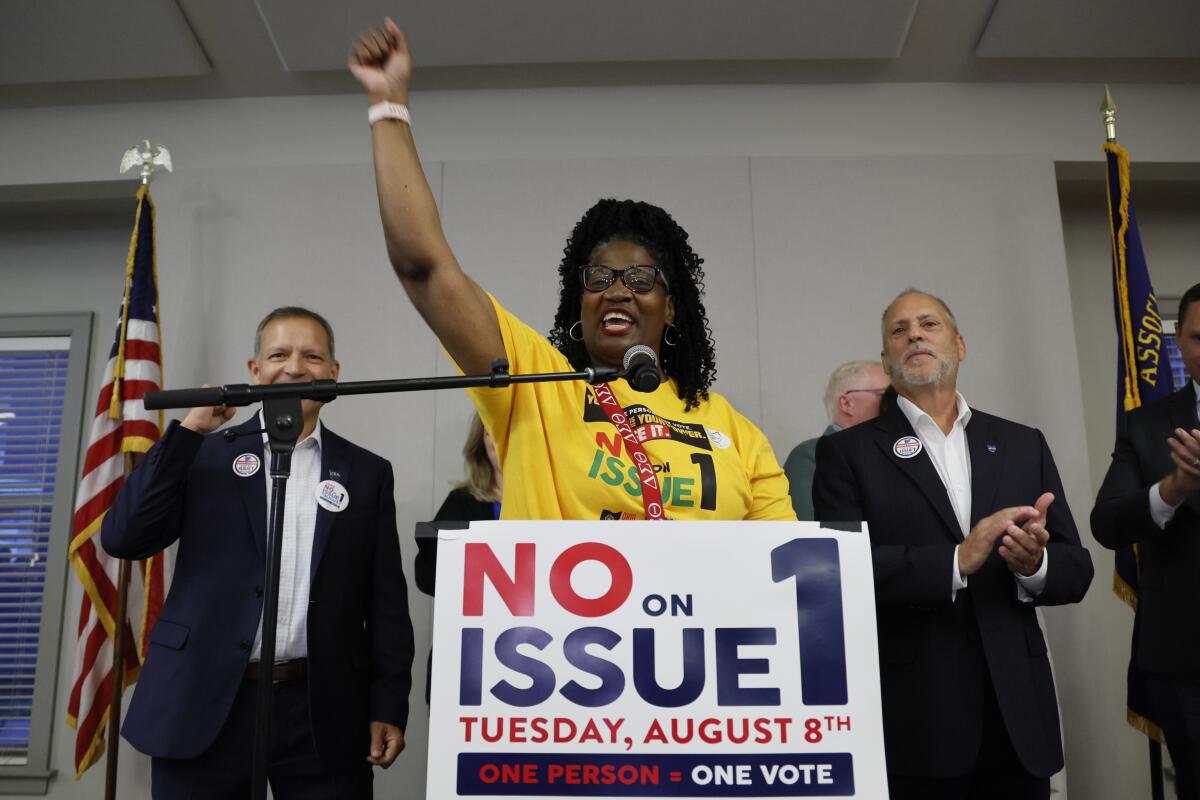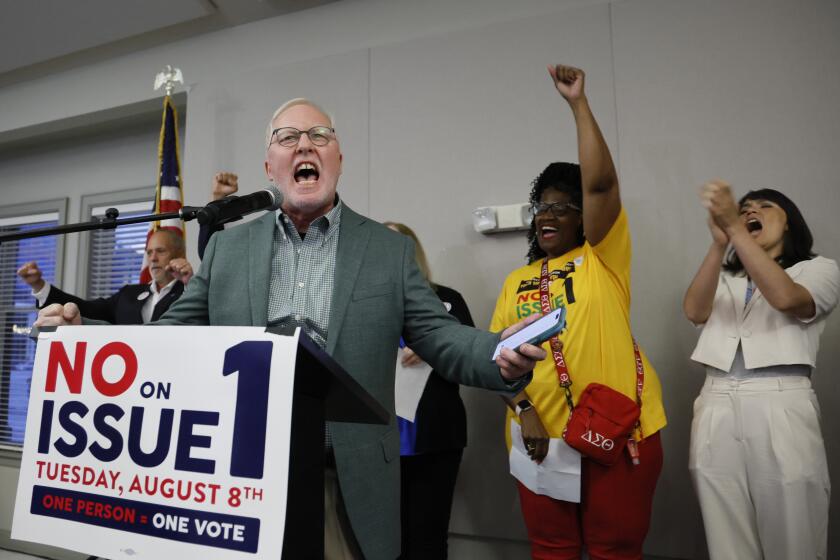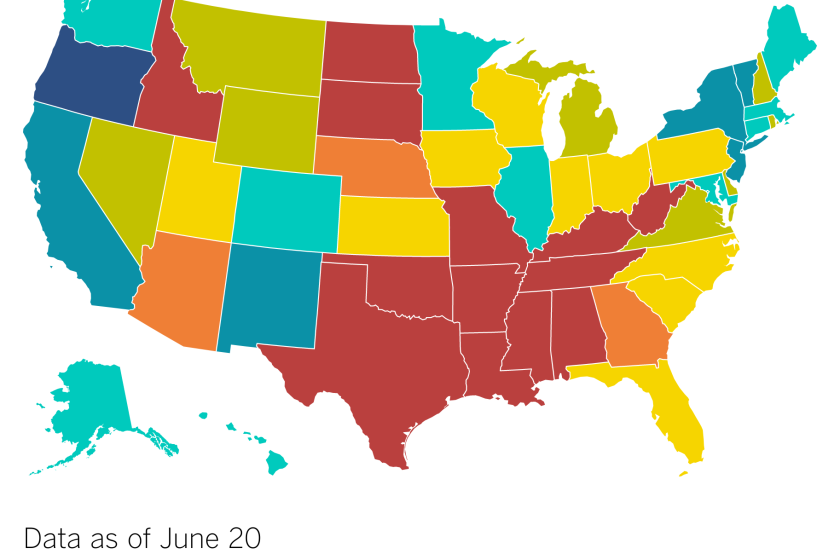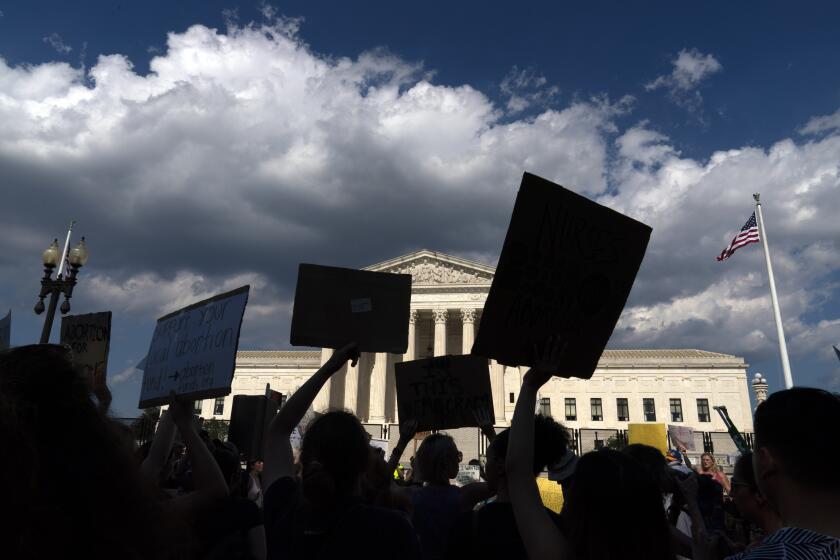Ohio vote shows power of abortion rights at ballot box, and a path for Democrats in 2024

- Share via
CHICAGO — Abortion wasn’t technically on the ballot in Ohio’s special election. But the overwhelming defeat of a measure that would have made it tougher to enshrine abortion rights in the state constitution this fall was the latest indicator that the issue remains a powerful force at the ballot box.
The election saw record turnout for what’s typically a sleepy August vote, and sets up another battle in November, when Ohio will be the only state to have reproductive rights on the ballot.
Tuesday’s results also give hope to Democrats and other abortion rights supporters who say the matter could sway voters their way again in 2024 — when it could affect races for president, Congress and statewide offices, and when places such as the battleground of Arizona may put abortion questions on their ballots as well.
Democrats described the victory this week in Ohio, a onetime battleground state that has shifted markedly to the right, as a “major warning sign” for the GOP.
“Republicans’ deeply unpopular war on women’s rights will cost them district after district, and we will remind voters of their toxic antiabortion agenda every day until November,” said Aidan Johnson, a spokesperson for the Democratic Congressional Campaign Committee.
The measure Ohio voters rejected Tuesday, known as Issue 1, would have required ballot questions to pass with 60% of the vote rather than a simple majority. With the count nearly completed, votes against the measure were at 57% compared with 43% in favor — a lead of almost 430,000 votes.
Voters in Ohio reject GOP-backed proposal that would have made it tougher to protect abortion rights
Voters in Ohio resoundingly reject a Republican-backed constitutional change that would have made it more difficult to pass abortion protections.
Interest in the measure was unusually high, with both sides spending millions and turnout by far the highest in Ohio for an August election, which in the past have been mainly limited to local races. Turnout was even higher than the most recent off-year November election, when voters in 2017 decided two statewide ballot measures.
Opposition to the measure, which became a kind of proxy for November’s abortion vote, extended even into traditionally Republican areas. In early returns, support for the measure fell far short of former President Trump’s performance during the 2020 election in nearly every county.
The November ballot question will ask voters whether individuals should have the right to make their own reproductive healthcare decisions, including on contraception, abortion, fertility treatment and miscarriage care.
Ohio’s GOP-led state government in 2019 approved a ban on abortion after activity is detected in the fetal cells that would form a heart — around six weeks, before many women know they are pregnant. But the ban was not enforced due to the 1973 U.S. Supreme Court ruling in Roe vs. Wade, which granted a federal right to the procedure.
Last year, when a new conservative majority on the high court overturned the nearly 50-year-old ruling, sending authority over the procedure back to the states, Ohio’s ban briefly went into effect. But a state court put the ban on hold again while a challenge alleging it violates the state constitution plays out.
During the time the ban was in place, an Indiana doctor came forward to say she had performed an abortion on a 10-year-old rape victim from Ohio who could not legally have the procedure in her home state. The account became a national flashpoint in the debate over abortion rights and underscored the stakes in Ohio.
Man charged with rape of 10-year-old Ohio girl who had to travel to Indiana for an abortion because of new restrictions in her home state.
Ohio is one of about half of the U.S. states where citizens may bypass the Legislature and put ballot questions directly to voters, an option that supporters of reproductive rights have increasingly turned to since Roe vs. Wade fell.
After abortion rights supporters said they hoped to ask voters in November to enshrine the right in the state constitution, Ohio Republicans put Issue 1 on Tuesday’s ballot. In addition to raising the threshold to pass a measure, it would have required signatures to be collected in all of Ohio’s 88 counties, rather than the current 44.
The 60% threshold was no accident, abortion rights supporters say, and was aimed directly at defeating the Ohio abortion measure. Since Roe vs. Wade was overturned, six states have had elections regarding reproductive rights. In every election — including in conservative states like Kansas — voters have supported abortion rights.
In Kansas, 59% voted to preserve abortion rights protections. In Michigan, 57% favored an amendment that put protections in the state constitution. Last year, 59% of Ohio voters said abortion should generally be legal, according to AP VoteCast, a broad survey of the electorate.
A year after the Supreme Court overturned Roe vs. Wade, leaving abortion decisions to states, where is abortion banned or protected? What comes next?
Last month, a poll by the Associated Press-NORC Center for Public Affairs Research indicated that the majority of U.S. adults want abortion to be legal at least through the initial stages of pregnancy. The poll found that opinions on abortion remain complex, with most people believing abortion should be allowed in some circumstances but not in others.
Opponents of the Ohio abortion question ran ads claiming, experts say wrongly, that the measure could strip parents of their ability to make decisions about their children’s healthcare or to even be notified about it.
Amy Natoce, spokesperson for the antiabortion campaign Protect Women Ohio, called the ballot measure a “dangerous anti-parent amendment.”
Several legal experts have said there is no language in the amendment supporting the ads’ claims.
Peter Range, chief executive of Ohio Right to Life, said he has been traveling across Ohio talking to people.
“I’ve never seen the grassroots from the pro-life side more fired up to go and defend and protect the pre-born,” he said.
While the November question pertains strictly to Ohio, access to abortion there is pivotal to access across the Midwest, said Alison Dreith, director of strategic partnership for the abortion fund Midwest Access Coalition.
Most U.S. adults, even in states with strict abortion limits or bans, want it to be legal at least through the initial stages of pregnancy, a poll finds.
Nine Midwestern states — Indiana, Iowa, Kansas, Ohio, Nebraska, Missouri, North Dakota, South Dakota and Wisconsin — are considered restrictive, very restrictive or most restrictive of abortion rights by the Guttmacher Institute, a research and policy organization that supports legal access to abortion.
“Ohio in particular has always been a destination state for the states around it,” Dreith said. “If we don’t protect abortion access in Ohio, the options just continue to shrink for people seeking care in the Midwest.”
Sri Thakkilapati, executive director of the Cleveland-based nonprofit abortion clinic Preterm, said the effect of the Ohio vote will reverberate throughout the country.
“When we restrict access in one state, other states have to take up that patient load,” she said. “That leads to longer wait times, more travel, higher costs for patients.”
Thakkilapati called the energy around abortion rights in last year’s midterm election “exciting.” But she said the media attention has died down, and people quickly forgot “how tenuous abortion access is right now.” The special election and ballot measure in Ohio are “a reminder of what’s at stake,” she said.
“Other states are watching how this plays out in Ohio, and it may give antiabortion groups in other states another strategy to threaten abortion rights elsewhere,” she said. “And for the majority who do want abortion access in their states but are seeing it threatened, the results in November could give them hope that the democratic process may give them relief.”
Kimberly Inez McGuire, the executive director of Unite for Reproductive and Gender Equity, which focuses on people of color younger than 30, says the results of elections involving reproductive rights show that support isn’t just from Democrats or cities and states considered liberal bastions.
“There was this idea that we couldn’t win on abortion in red states, and that idea has really been smashed” along with the “mythology” that people in the South and Midwest won’t support abortion rights, McGuire said.
“I think 2024 is going to be huge,” she said. “And I think in many ways, Ohio is a proving ground — an early fight in the lead up to 2024.”
Dreith said that since abortion hasn’t been on a major ballot since last year, Ohio’s vote this fall is “a good reminder” for the rest of the country.
“Abortion is always on the ballot — if not literally ... figuratively through the politicians we elect to serve us,” she said. “It’s also a reminder that this issue isn’t going away.”
Associated Press writer Stephen Ohlemacher in Washington contributed to this report.
More to Read
Get the L.A. Times Politics newsletter
Deeply reported insights into legislation, politics and policy from Sacramento, Washington and beyond. In your inbox three times per week.
You may occasionally receive promotional content from the Los Angeles Times.













